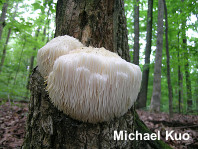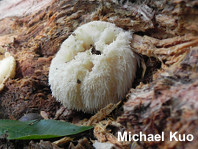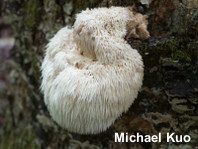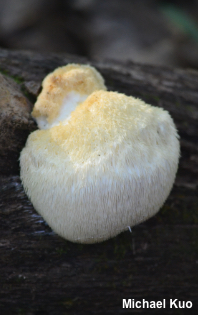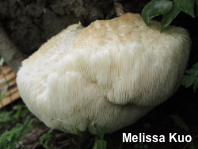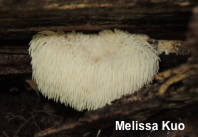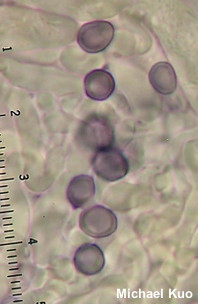| Major Groups > Toothed Mushrooms > Hericium > Hericium erinaceus |

|
Hericium erinaceus [ Basidiomycota > Russulales > Hericiaceae > Hericium . . . ] by Michael Kuo In theory, this species of Hericium is easy to identify: it is the only species that forms a single clump of dangling spines, rather than hanging its spines from a branched structure. Additional identifying features include the fact that it typically appears on the wounds of living or very recently cut hardwoods, and the fact that its spines are mostly more than 1 cm in length. That's the theory. In practice positive identification is more difficult, since immature specimens of the branched species of Hericium often begin more or less as a single clump, and develop their branches with age. Further confusion stems from the fact that the long-spined species of Hericium, like Hericium erinaceus, may have short spines (1 cm in length or less) when they are young. In short, you must be sure that your specimen is mature (look for signs of brownish or yellowish discoloration) before betting the house on your identification of Hericium erinaceus. As it is currently defined Hericium erinaceus is found across the globe—but preliminary DNA anylsis by Hallenberg and collaborators (2013) supports the possibility that there are several phylogenetic species involved, some or all of which may be at least partially delimited by geography. Description: Ecology: Saprobic and parasitic; usually growing alone or in pairs; fruiting from the wounds of living hardwoods (especially oaks); late summer and fall, or over winter and spring in warmer climates; originally described from France; widespread in Europe; in North America widely distributed from Canada to Mexico; also found in Central America and Asia. The illustrated and described collections are from Illinois and Missouri. Fruiting Body: 8–24 cm across; consisting of one, unbranched clump of 1–4 cm long, soft spines hanging from a tough, hidden base that is attached to the tree; top of mature fruiting body often with shortened spines that appear hairy; spines white, or in age discoloring brownish to yellowish. Flesh: White; not changing when sliced; soft; spongy. Odor and Taste: Not distinctive. Spore Print: White. Microscopic Features: Spores 5–6 x 5.5–6 µm; globose to subglobose or subellipsoid; smooth or minutely roughened; hyaline and uniguttulate in KOH; amyloid. Gloeoplerous hyphae present, sometimes extending into hymenium to become cystidia (up to 50 x 6 µm, cylindric with knobbed apices, smooth, thin-walled). REFERENCES: (Bulliard, 1781) Persoon, 1797. (Fries, 1821; Saccardo, 1888; Hall & Stuntz, 1971; Harrison, 1973; Phillips, 1981; Smith, Smith & Weber, 1981; Ginns, 1985; Weber & Smith, 1985; Arora, 1986; States, 1990; Lincoff, 1992; Metzler & Metzler, 1992; Horn, Kay & Abel, 1993; Stalpers, 1996; Roody, 2003; Miller & Miller, 2006; Nonis, 2007; Kuo, 2007; Binion et al., 2008; Buczacki et al., 2013; Hallenberg et al., 2013; Kuo & Methven, 2014; Desjardin, Wood & Stevens, 2015; Siegel & Schwarz, 2016; Gminder & Böhning, 2017; Kibby, 2017; Woehrel & Light, 2017; Baroni, 2017; Elliott & Stephenson, 2018; Læssøe & Petersen, 2019; Sturgeon, 2019; McKnight et al., 2021.) Herb. Kuo 07280303, 09301701, 05041901. This website contains no information about the edibility or toxicity of mushrooms. |
© MushroomExpert.Com |
|
Cite this page as: Kuo, M. (2022, July). Hericium erinaceus. Retrieved from the MushroomExpert.Com Web site: http://www.mushroomexpert.com/hericium_erinaceus.html |
